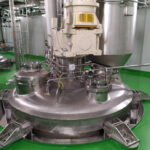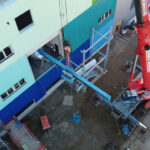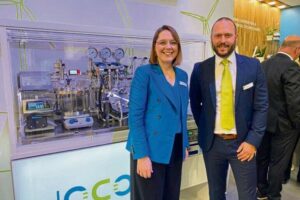Firmen im Artikel
Amino acids are organic compounds that make up proteins and that play an important role in our body. For example, arginine, cysteine, and lysine are involved in numerous bodily processes. There are a total of 20 amino acids that are important for humans, although the body only produces nine of them on its own. Other building blocks such as leucine or threonine must therefore be obtained through our diet. Amino GmbH has been producing all amino acids of the highest quality for a wide range of applications since 1958.
Focus on quality
These applications include active pharmaceutical ingredients (APIs) and nutrients used in both adult and, especially, infant nutrition. In other words, they produce sensitive products that are made under very strict regulations. Amino GmbH has aligned its operations with these market demands, customizing its products to meet the needs of international customers. This focus on quality is captured in their slogan: “high-quality products, pure and just-in-time.” “We supply the pharmaceutical industry and the infant nutrition industry, which means particularly high-quality standards. Microbial contamination is an absolute no-go for us,” explains Kai-Philipp Thomas, Head of Sales at Amino GmbH.
Drying technologies perfectly fits
Amino has therefore been counting on BHS-Sonthofen’s reliable process technology for around twenty years. The two companies have built a strong, trust-based partnership. “From our very first project, we saw that BHS’s drying technologies perfectly fit our needs. BHS has proven to be a dependable partner, and we’ve relied on them ever since,” says Gerrit Dierking, Production Manager at Amino, reflecting on the successful collaboration.
BHS-Sonthofen supports its clients with a mix of process engineering expertise, a diverse range of technologies, and personalized consulting tailored to their specific needs. The focus is on custom solutions that take into account the unique properties of each product. As Martin Specht, Area Sales Manager, puts it: “We see ourselves as problem solvers. When partnering with a company like Amino, we use our process expertise to collaborate with the customer and find the best process technology solution for their specific product.”
Gentle vacuum drying maintains product integrity
Amino acids are especially sensitive to temperature, so the production technologies need to account for this. That’s why it’s crucial for Amino to use processes designed for temperature-sensitive products throughout the entire process. BHS’s vertically built conical dryers are ideal for this, as they offer gentle processing by drying in a vacuum at low temperatures
The BHS conical dryer features a vertical, cone-shaped vessel with a mixing helix mounted near the side walls. It’s designed for fast processing while ensuring maximum product protection. “The relatively low temperatures are crucial for amino acids,” says Specht. “Vacuum, which is applied while the machine is being loaded, causes the water to evaporate immediately. Traditional technologies operate at higher temperatures, which can harm the product.”
Helix mixing principle minimizes shear forces
High temperatures aren’t the only thing that can negatively impact the product; excessive mechanical stress can also damage amino acids. The BHS conical dryer’s mixing design helps protect the product from damage due to shear forces. The mixing helix moves the product up along the heated walls of the container, while the product inside the chamber flows back down to the bottom. This constant movement ensures even heat distribution and uniform moisture throughout the product. It’s crucial for the further processing that the particle size distribution remains consistent from the machine’s inlet to its discharge. The big advantage of BHS technology is that the helix mixing principle reduces shear forces on the product. “With vertical vacuum drying, the product isn’t harmed by excessive thermal or mechanical stress,” Specht says, highlighting the benefits of BHS technology.
The dryer operates in batch mode. “Each product from Amino has specific temperature and moisture needs. We have much better control over these variables with batch processing,” Specht explains. The vertical design also makes cleaning and emptying the machine easier.
Effective cleaning – no risks
Amino’s production facility handles a variety of products, so it’s essential to quickly empty the machines with minimal residue left behind. The vertical design of BHS dryers and their closed system effectively reduce risks like cross-contamination, bacterial growth, and external contaminants. Unlike paddle dryers, the conical dryer features optimal angles that create a silo effect, ensuring that every bit of product is discharged completely.
Two conical dryers with 8500 liters capacity
Amino is now facing an expanding international market. “We have seen significant growth in recent years due to rising demand for essential amino acids. We’ve also been expanding our product range,” says Dierking. To keep up with this growth, Amino needed an innovative solution for handling larger volumes.
After BHS supplied a continuous vacuum indexing belt filter (model BF 100–030) with a downstream dryer (model HVW-T 2500) in 2019, Amino decided to install a new production line two years later. This new line features two identical conical dryers (model HVW-T 8500) designed for pharmaceutical cGMP standards (current Good Manufacturing Practice), each with a capacity of 8500 liters. “The focus was on high throughput. A total capacity of 8500 liters is unusually large for the pharmaceutical industry, where volumes typically range from 500 to 5000 liters,” Specht notes.
Semi-continuous operation with short process times
BHS developed a new process to ensure high throughput with an innovative filling method. “The second dryer is filled once the first dryer reaches its maximum fill level, allowing for alternate filling in a vacuum within a sophisticated lock system,” Specht explains. This approach transforms batch processing into a semi-continuous production method, cutting down the cycle time per batch. Filling is done via two peel centrifuges with vacuum-tight discharge to dry in a vacuum during filling.
Drying starts while the machine is filling. Once full, the inlet valve closes, and the machine reaches full drying capacity. This setup enables the semi-continuous production of various products with short process times. Costs are reduced by cooling the product within the same machine at the end of the drying cycle. “The heating and cooling technology, with primary and secondary circuits, was part of the supplied system,” Dierking explains. “We consider it exactly the right technology for the job.” The amino acids are carefully discharged in the final step and packed into big bags for distribution. Additionally, vacuum drying requires less cooling energy for product filling due to lower temperatures.
Both conical dryers are designed with minimal dead space, generous radii, and efficient CIP cleaning nozzles. This design results in a low-maintenance operation. “We’re very satisfied with the BHS system’s performance after a year and a half,” Dierking concludes. “Even the challenging installation was made possible thanks to BHS’s expert technical team. That is why we will continue to rely on BHS’s process expertise in the future.”
BHS-Sonthofen Process Technology GmbH, Sonthofen











